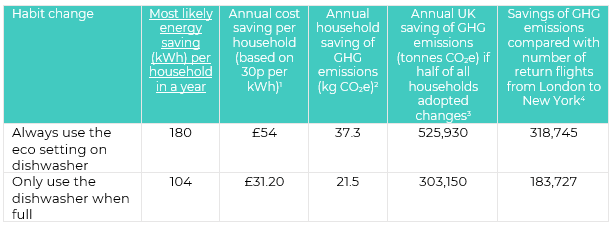
By Juliette Kellow, Registered Dietitian
Continued from Part 1 (keeping food cool) , Part 2 (prepping food) and Part 3 (climate friendly cooking) of our sustainable kitchen mini blog series, here Juliette Kellow explores the importance of the kitchen clean up…
Tidying after meals uses a variety of resources that impact the environment, including water (and energy to make it hot), materials such as pan scrubs, clothes and cleaning sprays, and often food coverings such as clingwrap or tin foil. Fortunately, the impact can be lowered.
Using a dishwasher rather than washing up by hand is a good starting point. In one US study, researchers replicated dishwashing conditions and found over a typical 10-year life cycle, dishwashers produced 63% fewer greenhouse gas emissions than washing up by hand, and used far less water – 74,100 litres of water compared with 155,476 litres, respectively. To maximise their green potential and save money, dishwashers should be fully loaded and run on an eco-setting or lower temperature (see chart below). Avoid rinsing before loading to keep water usage low too. For those without dishwashers, using a washing up bowl uses less water than filling the sink or washing under running water. There’s a financial benefit, too. According to Water UK, one less dishwasher cycle each week would save £17 a year.

For greener cleaning use reusable, washable cloths rather than single-use wipes or kitchen paper as these are more environmentally friendly. Kitchen rolls, for example, have a large environmental impact. Though they’re usually made from recycled paper, kitchen towels can’t be recycled themselves after being used to clean up so end up in landfill (the paper is biodegradable but this can take up to a year and, as it decomposes, it releases greenhouse gases); they’re usually packaged in plastic; and they’re big and bulky so take up a lot of space requiring more lorry loads for transporting them. It’s good news then that a Mintel report found 26% of UK consumers reduced their use of kitchen rolls in the last six months of 2022 due to the rising cost of living.
Looking at how leftover food is wrapped for the fridge or freezer is also important. Cling wrap, plastic bags and tin foil all come with a financial and environmental cost so encourage clients to switch to reusable kitchen containers or empty and clean margarine, takeaway and ice cream tubs with lids (bear in mind these are not usually designed to withstand high temperatures, so shouldn’t go into the microwave). Foil can be washed and reused. If it’s coming to the end of its life, it can be used to line roasting tins and grill pans – they’ll be easier to clean up and won’t need pre-dishwasher scrubbing, which adds to water use.
Part 5 coming soon. We hope this blog has given you lots of useful tips… do comment below and let us know.
This blog was peer reviewed by the MyNutriWeb Nutrition and Dietetic team 23/09/2023.
YOU MAY ALSO BE INTERESTED IN:
A Sustainable Kitchen – Keeping Food Cool
A Sustainable Kitchen – Prepping Food
A Sustainable Kitchen – Climate Friendly Cooking
Sustainable Diets: Key Updates







Great series!